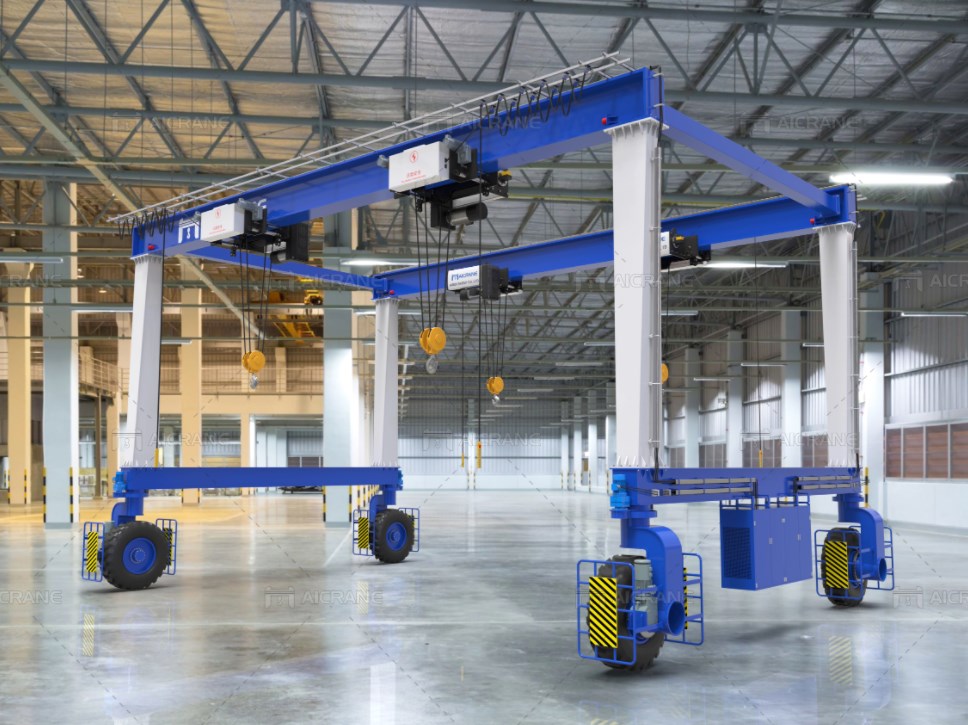How Rubber-Tired Gantry Cranes Revolutionize Industrial Operations
In the sphere of manufacturing and industrial settings, the demand for efficient and adaptable solutions is paramount. Rubber-tired gantry cranes (RTGs) have emerged as a cornerstone in these environments, providing a mobile and versatile approach to material handling. Unlike traditional gantry cranes confined to fixed rails, RTGs, with their rubber tires, offer the flexibility needed to navigate manufacturing floors and industrial spaces, transforming the way materials are managed.
Overview of Rubber-Tired Gantry Cranes in Industrial Settings
A rubber-tired gantry crane in an industrial context is a mobile crane equipped with rubber tires, allowing it to move seamlessly across factory floors and industrial facilities. The unique design of RTGs, with a steel framework mounted on four rubber tires, facilitates mobility and flexibility in navigating complex layouts commonly found in manufacturing environments. This adaptability optimizes space utilization and enhances the efficiency of material handling operations.
Structure and Components
The structure of an RTG used in manufacturing and industrial settings typically comprises a sturdy steel framework mounted on four rubber tires, arranged in a 2x2 configuration. The crane features a lifting mechanism, a spreader beam, and an operator cabin. The lifting mechanism, consisting of a hoist and a trolley, moves horizontally along the gantry structure. The spreader beam, attached to the hoist, secures materials during lifting and transportation.
Mobility and Flexibility on the Factory Floor
One of the primary advantages of rubber tire cranes in industrial settings is their mobility. The rubber tires enable the crane to navigate freely across the factory floor, reaching materials stored in various locations. This eliminates the need for fixed rail systems, providing factories with the flexibility to adapt to changing production requirements and layouts.
Material Handling in Manufacturing
The operational process of an RTG in a manufacturing or industrial setting begins when materials need to be moved within the facility. The operator, stationed in the cabin, utilizes a control panel to maneuver the crane to the desired location. Once in position, the hoist and trolley are engaged to lift the materials off the ground. The spreader beam securely grips the materials, ensuring stability during lifting and transportation.
Stacking and Retrieving Materials
Rubber-tired gantry cranes excel at stacking materials in dedicated storage areas within manufacturing facilities. As the crane moves along the material stacks, the operator can efficiently position materials on top of each other, optimizing vertical storage space. When specific materials need to be retrieved for the production process, the RTG can navigate to their location, pick them up, and transport them to the designated work area.
Adaptability to Various Material Sizes
One noteworthy feature of RTGs is their ability to handle materials of different sizes. The adjustable spreader beams allow these cranes to securely grip materials with varying dimensions. This adaptability is crucial in industrial settings where a wide range of materials, from small components to larger assemblies, needs to be efficiently handled.
Automation and Remote Operation
To address the need for enhanced efficiency and labor optimization, many modern rubber-tired gantry cranes are equipped with automation features suitable for industrial applications. These cranes can be programmed to perform predefined tasks, such as stacking or retrieving materials, without constant operator supervision. Remote operation capabilities enable operators to control the crane from a centralized location, further improving safety and operational efficiency.
Integration with Industrial Management Systems
The seamless integration of rubber-tired gantry cranes into industrial management systems underscores the technological advancements in material handling. These systems leverage real-time data and analytics to optimize the movement of materials within the facility. By coordinating the activities of multiple RTGs, the management system minimizes congestion, reduces turnaround times, and enhances overall operational efficiency in manufacturing and industrial environments.
Environmental Considerations
In alignment with the increasing focus on environmental sustainability, RTGs used in manufacturing and industrial settings are adopting eco-friendly technologies. Electric-powered rubber-tired gantry cranes, for instance, significantly reduce emissions compared to traditional diesel-powered alternatives. Additionally, regenerative braking systems contribute to a greener and more sustainable material handling process.



Comments
Post a Comment